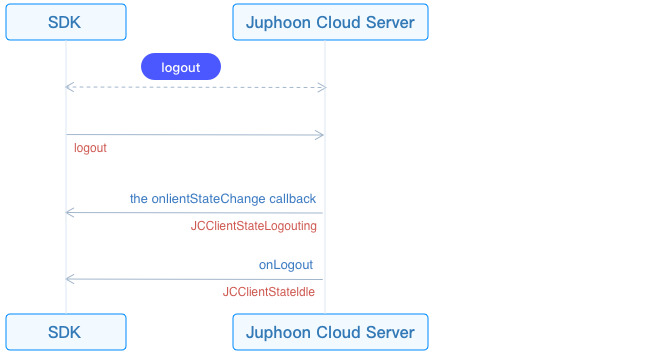# Log In
This guide introduces how to initialize JC SDK and log in.
# Initialize
Before calling the initialize method, you need to extend the JCClientCallback object, and then implement the pure virtual function in the JCClientCallback object:
class JCManager : public JCClientCallback
{
public:
//Singleton instance management class
JCManager();
~JCManager();
static std::shared_ptr<JCManager> shared();
bool initialize();
void uninitialize();
//The callback of Login
virtual void onLogin(bool result, JCClientReason reason);
//Logout callback
virtual void onLogout(JCClientReason reason);
//The callback of ClientStateChange
virtual void onClientStateChange(JCClientState state, JCClientState oldState);
public:
//JCClient object
JCClient* client;
};
Call the
createJCClient (opens new window)
method in the JCClientImpl class on the main thread, and pass in the
obtained appKey to initialize the JC SDK.
bool JCManager::initialize()
{
//Initialize
client = createJCClient("User appKey", this, NULL);
if (client->getState() == JCClientStateNotInit) {
return false;
}
return true;
}
//The callback of Login
void JCManager::onLogin(bool result, JCClientReason reason) {
}
//The callback of Logout
void JCManager::onLogout(JCClientReason reason) {
}
//The callback of ClientStateChange
void JCManager::onClientStateChange(JCClientState state, JCClientState oldState) {
}
After initialization is successful, the JCClient state changes to JCClientStateIdle (not logged in state).
# Initiate login
After the SDK is initialized, login integration is possible.The call flow of the login interface is as follows:

Create JCClientLoginParam (opens new window) object to set login parameters and call login (opens new window) to initiate login:
//Login
void JCSampleDlg::OnBnClickedButtonLogin()
{
int state = JCManager::shared()->client->getState();
if (state == JCClientStateIdle) {
JCClientLoginParam* loginParam = new JCClientLoginParam();
// 1. Environment settings
loginParam->serverAddress = "Server address";
// 2. Initiate login
JCManager::shared()->client->login("username", "123", loginParam);
}
else {
// Log out if already logged in
JCManager::shared()->client->logout();
}
}
TIP
Environment settings:
- Domestic environment
http:cn.router.justalkcloud.com:8080(Default) - International environment
http:intl.router.justalkcloud.com:8080
- Domestic environment
userID is English, numbers and
+-_., case-insensitive, the length should not exceed 64 characters,-_.cannot be the first character.password the length should not exceed 128 characters.
When calling this interface returns true, it only means that the interface is called successfully, not that the login is successful. The result of the login will be reported through the onLogin callback.
After the interface is successfully called, the callback of login state change onClientStateChange (opens new window) will be triggered, and you can perform logical operations in this callback:
void JCManager::onClientStateChange(JCClientState state, JCClientState oldState) {
if (state == JCClient.STATE_IDLE) { // Not logged in
...
} else if (state == JCClientStateLogining) { // Logging in
...
} else if (state == JCClientStateLogined) { // Login successful
...
} else if (state == JCClientStateLogouting) { // Logout
...
}
}
After that, the onLogin (opens new window) callback is triggered. You can perform logical operations in the callback:
void JCManager::onLogin(bool result, JCClientReason reason) {
if (result) {/// Login successful
...
}
if (reason == JCClientReasonAuth) {// Account password is wrong
...
}
}
After successful login, the JCClientState status changes from JCClientStateIdle (not logged in) to JCClientStateLogined (successful login). The SDK will automatically remain connected to the server until the user calls the logout interface, or the device is logged in because the account is logged in on another device. For login successful/failed reasons, please refer to JCClientReason (opens new window) .
# Log out
The call flow of the logout interface is as follows:

Call logout (opens new window) to initiate logout:
JCManager::shared()->client->logout();
Logging out will also trigger a login state change (onClientStateChange) callback, after which the logout result will be reported via the onLogout callback:
void JCManager::onLogout(JCClientReason reason) {
if (reason == JCClientReasonServerLogout) {// Force logout
...
}
}
For logout reasons, please refer to: JCClientReason (opens new window) .
After logging out successfully, the JCClientState status changes from JCClientStateLogined (successful login) to JCClientStateIdle (not logged in).

